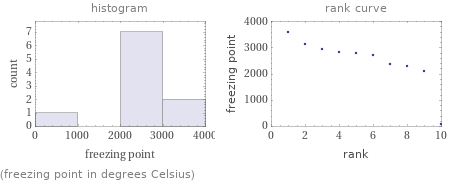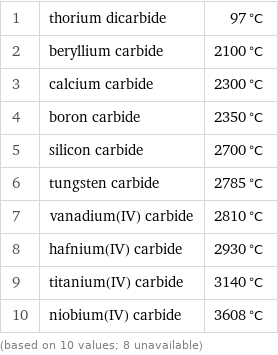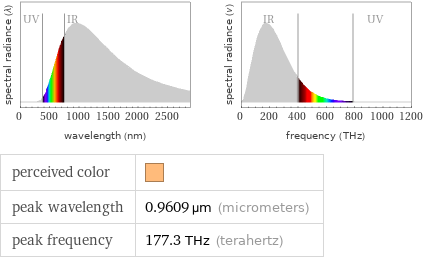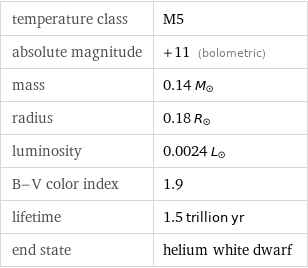Input interpretation

carbides | freezing point
Summary

median | 2743 °C highest | 3608 °C (niobium(IV) carbide) lowest | 97 °C (thorium dicarbide) distribution | | (based on 10 values; 8 unavailable)
Entities with missing values

zirconium(IV) carbide | molybdenum carbide | yttrium carbide | aluminum carbide | lanthanum carbide | cerium carbide | chromium carbide | tantalum(IV) carbide (total: 8)
Distribution plots

(freezing point in degrees Celsius)
Freezing point rankings

1 | thorium dicarbide | 97 °C 2 | beryllium carbide | 2100 °C 3 | calcium carbide | 2300 °C 4 | boron carbide | 2350 °C 5 | silicon carbide | 2700 °C 6 | tungsten carbide | 2785 °C 7 | vanadium(IV) carbide | 2810 °C 8 | hafnium(IV) carbide | 2930 °C 9 | titanium(IV) carbide | 3140 °C 10 | niobium(IV) carbide | 3608 °C (based on 10 values; 8 unavailable)
Unit conversions for median freezing point 2743 °C

3016 K (kelvins)

4969 °F (degrees Fahrenheit)

5428 °R (degrees Rankine)

2194 °Ré (degrees Réaumur)

1447 °Rø (degrees Rømer)
Blackbody information for median freezing point 2743 °C (degrees Celsius)

perceived color | peak wavelength | 0.9609 µm (micrometers) peak frequency | 177.3 THz (terahertz)
Corresponding main-sequence star properties for median freezing point 2743 °C (degrees Celsius)

temperature class | M5 absolute magnitude | +11 (bolometric) mass | 0.14 M_☉ radius | 0.18 R_☉ luminosity | 0.0024 L_☉ B-V color index | 1.9 lifetime | 1.5 trillion yr end state | helium white dwarf
Examples of M5 main-sequence stars

Luyten's Star | GJ 1080 | GJ 1126 B | V0442 Tauri | FI Tauri | AB Doradus Ba
Corresponding quantities

Thermodynamic energy E from E = kT: | 26 ceV (centielectronvolts)

Blackbody energy flux Φ from Φ = σT^4: | 4.69×10^6 W/m^2 (watts per square meter)

Approximate luminous exitance from a planar blackbody radiator perpendicular to its surface: | 9.92×10^7 lx (lux)